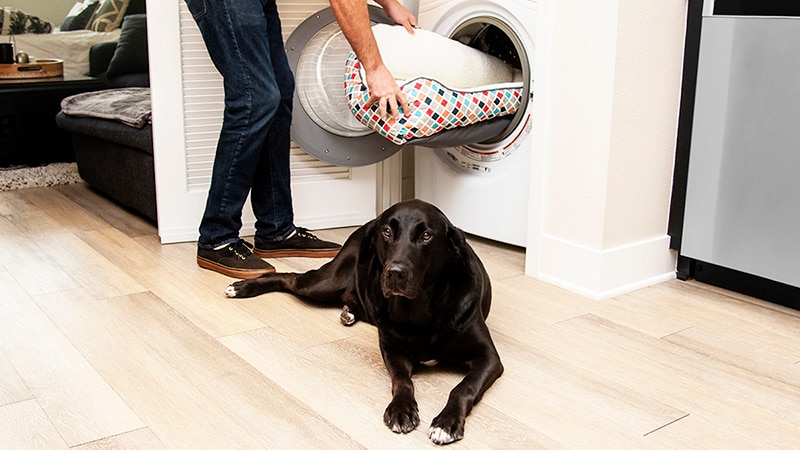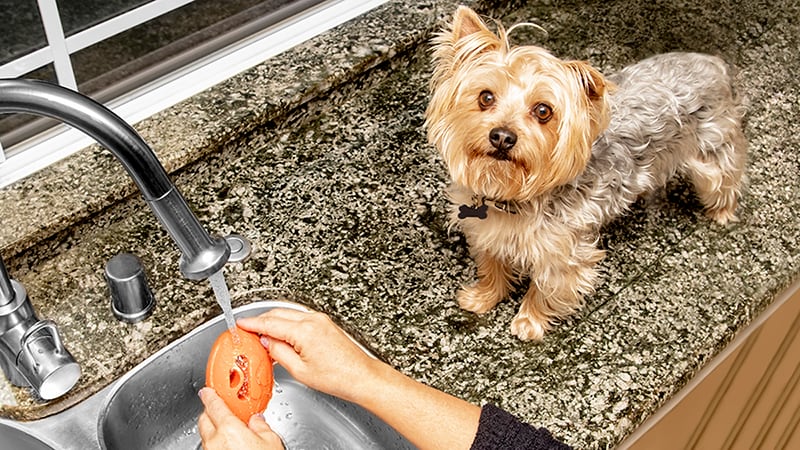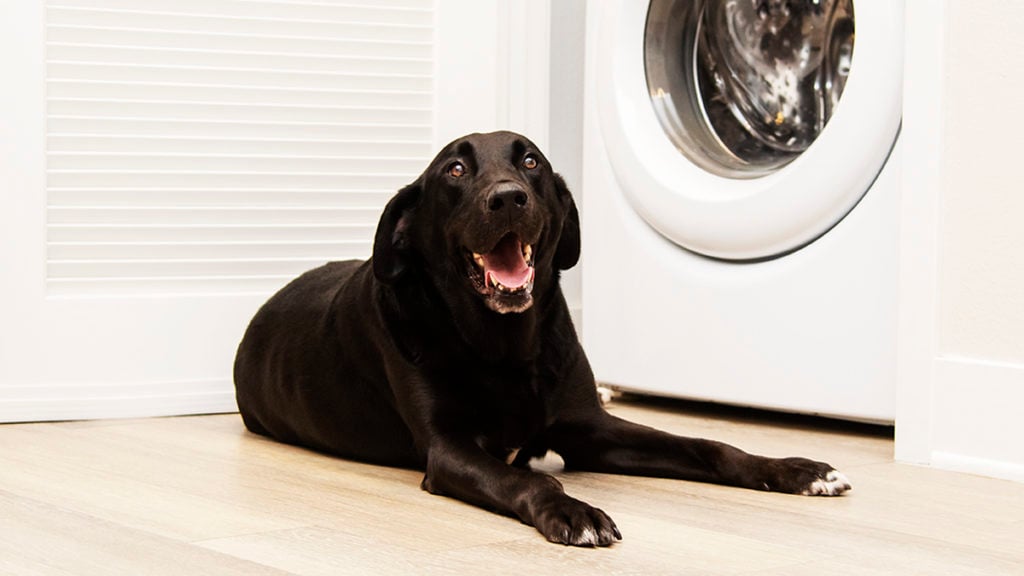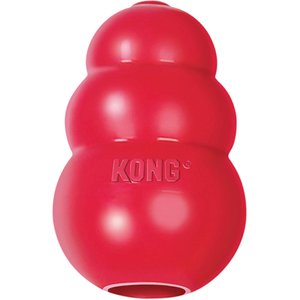When it comes to cleaning your pet supplies, you do have to think twice. Unlike cleaning items for human use, cleaning pet products requires more care to protect human and pet health.
Some of the cleaning products we typically use that are safe for humans can be detrimental to our pets’ health. And sometimes it can be easy to forget just how often we need to clean our pets’ beds, toys and other supplies.
Learn how to safely and properly clean a dog bed, cat bed and other important items in your pet’s life.
How to Clean a Dog Bed

By Jon Lofdahl
How often to wash pet bedding depends on several factors:
- How much the pet sheds
- How much time the pet spends outdoors
- If the pet has allergies
- If household members have allergies to the pet
In most cases, it is recommended to wash pet bedding once every 1-2 weeks. If anybody in your home suffers with pet allergies, your pet sheds a lot, or they spend a lot of time outdoors, then you might want to wash the bedding more often. Use your best judgement, and remember that the longer you go between washing, the harder the bedding will be to clean.
Machine wash all cat and dog beds with unscented detergent on the sanitation cycle or the hottest water cycle available, assuming the fabric can handle it. Pets with sensitive skin might benefit from an additional rinse at the end of the wash cycle, and bedding with polyester stuffing should be hung to dry because the dryer will cause clumping.
If your pet’s bedding is covered in hair, vacuum the bedding to remove as much hair as possible before running it through the washing machine. This will keep your washing machine from getting clogged and will allow the bedding to be cleaned more effectively.
It also is recommended to run an empty cycle after you wash pet bedding or pet toys to thoroughly clean your washer before running any human laundry. You can add some bleach to the empty cycle to effectively cut odors out of your washer.
How to Clean Pet Bowls

By Jon Lofdahl
Generally speaking, you can run pet bowls through the dishwasher or hand-wash them with hot, soapy water. Wash the dog or cat food bowl after every meal, and wash your pet’s water bowls every couple of days.
The most important aspect of cleaning pet bowls is to remove any bits of food, as these can harbor and grow bacteria even after running through the dishwasher. This especially is important because of pet food recalls due to salmonella, which can make you and your pet sick.
Utensils used to prepare your pet’s wet food or raw food should be washed daily. For kibble, use a dedicated scoop and wash it weekly.
For extra sanitization, soak food bowls in a solution of 1 tablespoon of unscented, liquid chlorine bleach diluted in 1 gallon of water after washing. Rinse well.
Note: Raw food can carry harmful bacteria. If you feed your pet a raw diet, it is critical to wash the food bowls and utensils daily and use disinfecting wipes or sprays to thoroughly disinfect any surface used to prepare food. Anyone who has a reduced immunity—such as the elderly, the very young, people infected with immune disorders or diseases, or organ transplant recipients—should wear gloves when washing pet bowls or feeding pets and always wash their hands after.
Read more about how to clean pet bowls the right way.
How to Clean Dog Toys

By Jon Lofdahl
If you’re wondering how to clean dog toys, they can be washed weekly or any time they are covered in dirt or slobber. Plush toys without holes can be machine washed on the sanitation cycle or the hottest setting with a teaspoon of detergent.
KONGs, ropes, squeaky toys, frisbees and other rubber toys can be washed in the dishwasher. Place 2-3 tablespoons of white vinegar in the bottom of the dishwasher. You also can hand wash these toys with a dedicated scrubber brush and hot, soapy water or vinegar, but make sure to rinse them well.
Note: Bones cannot be washed with any detergent, bleach or vinegar. Instead, wipe them clean with a warm, wet washcloth.
Want to get your dog in on the tidy action? Here’s how to teach your dog to put away their toys.
How to Clean a Cat Litter Box

By Jon Lofdahl
Litter boxes should be scooped daily for urine and feces, and cleaned thoroughly once a week depending on the litter used. Scoop urine clumps and feces into a plastic bag, tie the bag shut, and deposit it in an outdoor receptacle daily.
It is recommended to clean the litter box in a laundry sink or, better yet, outdoors with a hose or water bucket once a week. Do not clean the litter box in a kitchen sink, bathroom sink or bathtub.
You don’t want to wash cat litter boxes in a bathtub or bathroom sink because your cat might harbor harmful parasites or bacteria in their feces or urine. If this is your only option, then make sure you clean the tub or sink with dilute bleach when you are finished.
To clean the litter box, scrub it with a designated brush or sponge, hot water and unscented liquid soap—anything scented can irritate a cat’s nose and cause them to reject the box. Rinse the box and either dry it with a paper towel or let it air dry, and then refill the box with 2-3 inches of litter.
It is recommended to wear gloves and a paper mask while cleaning or scooping the litter box, and pregnant women should not clean litter boxes because of the risk of toxoplasmosis, an infection that can cause birth defects.
Read more about how to safely clean a cat’s litter box.
By using these recommendations, you can keep your pet’s items safe and clean. After cleaning any of your pet’s items, make sure to keep yourself safe by thoroughly washing your hands with hot, soapy water.
Share:













